
All Quiet on the Western Front is a novel by Erich Maria Remarque, a German veteran of World War I. The book describes the German soldiers' extreme physical and mental trauma during the war as well as the detachment from civilian life felt by many upon returning home from the war.

Lewis Milestone was an American film director. Milestone directed Two Arabian Knights (1927) and All Quiet on the Western Front (1930), both of which received the Academy Award for Best Director. He also directed The Front Page (1931), The General Died at Dawn (1936), Of Mice and Men (1939), Ocean's 11 (1960), and received the directing credit for Mutiny on the Bounty (1962), though Marlon Brando largely appropriated his responsibilities during its production.
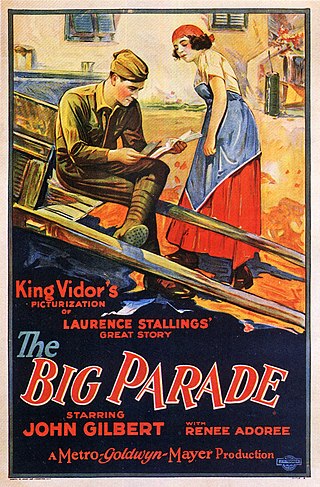
The Big Parade is a 1925 American silent war drama film directed by King Vidor, starring John Gilbert, Renée Adorée, Hobart Bosworth, Tom O'Brien, and Karl Dane. Written by World War I veteran Laurence Stallings, the film is about an idle rich boy who joins the U.S. Army's Rainbow Division, is sent to France to fight in World War I, becomes a friend of two working-class men, experiences the horrors of trench warfare, and finds love with a French girl. A sound version of the film was released in 1930. While the sound version of the film has no audible dialog, it featured a synchronized musical score with sound effects using both the sound-on-disc and sound-on-film process.
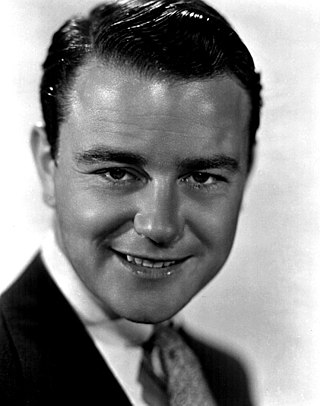
Lewis Frederick Ayres III was an American actor whose film and television career spanned 65 years. He is best known for starring as German soldier Paul Bäumer in the film All Quiet on the Western Front (1930) and for playing Dr. Kildare in nine films. He was nominated for an Academy Award for Best Actor for his performance in Johnny Belinda (1948).

The Nutty Professor is a 1963 American science fiction comedy film directed, co-written by, and starring Jerry Lewis. The film also co-stars Stella Stevens, Del Moore, Kathleen Freeman, Howard Morris, and Elvia Allman. The score was composed by Walter Scharf. A parody of Robert Louis Stevenson's 1886 novella Strange Case of Dr. Jekyll and Mr. Hyde, it follows bullied scientist Julius Kelp as he creates a serum that transforms him into a handsome man, which he subsequently uses under his alter ego Buddy Love.

A Walk in the Sun is a 1945 American war film based on the novel by Harry Brown, who was a writer for Yank, the Army Weekly based in England. The book was serialized in Liberty Magazine in October 1944.
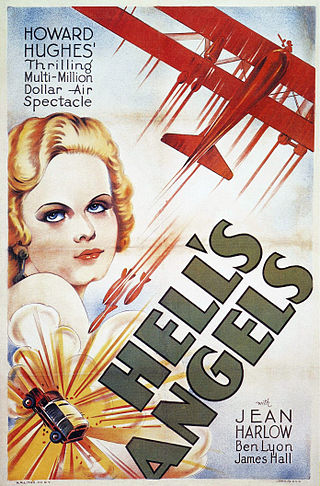
Hell's Angels is a 1930 American pre-Code independent epic war film directed and produced by Howard Hughes and director of dialogue James Whale. Written by Harry Behn and Howard Estabrook and starring Ben Lyon, James Hall and Jean Harlow, it was released through United Artists. It follows two dissimilar brothers, both members of the British Royal Flying Corps during the First World War.
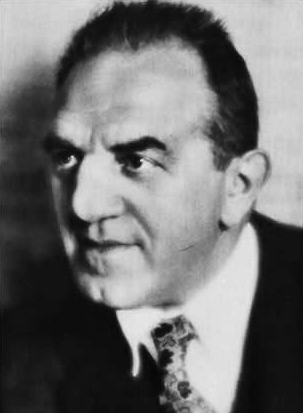
Louis Robert Wolheim was an American actor, of both stage and screen, whose rough physical appearance relegated him to roles mostly of thugs, villains and occasionally a soldier with a heart of gold in the movies, but whose talent allowed him to flourish on stage. His career was mostly contained during the silent era of the film industry, due to his death at the age of 50 in 1931.

Raymond Griffith was an American silent movie comedian. Later in his career, he worked behind the camera as writer and producer.

Westfront 1918 is a German war film, set mostly in the trenches of the Western Front during World War I. It was directed in 1930 by G. W. Pabst, from a screenplay by Ladislaus Vajda based on the novel Vier von der Infanterie by Ernst Johannsen. The film shows the effect of the war on a group of infantrymen portrayed by an ensemble cast led by screen veterans Fritz Kampers and Gustav Diessl.
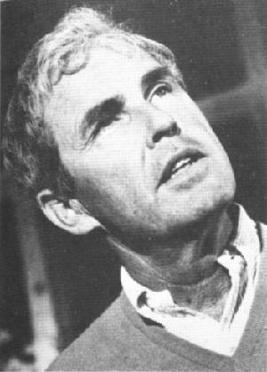
Robert Reese Parrish was an American film director, editor and former child actor. He won an Academy Award for Best Film Editing for his work on Body and Soul (1947).

Mrs. Miniver is a 1942 American romantic war drama film directed by William Wyler, and starring Greer Garson and Walter Pidgeon. Inspired by the 1940 novel Mrs. Miniver by Jan Struther, it shows how the life of an unassuming British housewife in rural England is affected by World War II. Produced and distributed by Metro-Goldwyn-Mayer, its supporting cast includes Teresa Wright, May Whitty, Reginald Owen, Henry Travers, Richard Ney and Henry Wilcoxon.

John J. Mescall, A.S.C. was an American cinematographer. He photographed such silent films as Ernst Lubitsch's The Student Prince in Old Heidelberg (1927), but he is best known for his work in the 1930s at Universal Pictures, where he often worked on the films of James Whale. Mescall was famous for his elaborate, some might say grandiose, effective camera movements, in which the camera would often track completely across or around a set, or even one performer. He did not always use these kinds of camera movements, but his most famous films all have them.

William Robertson Bakewell was an American actor. He achieved his greatest fame as one of the leading juvenile performers of the late 1920s and early 1930s.
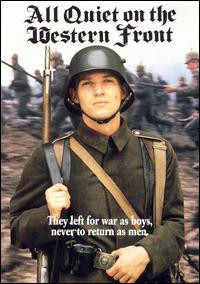
All Quiet on the Western Front is an epic anti-war television film produced by ITC Entertainment. It was released on November 14, 1979. Based on the 1929 book of the same name by Erich Maria Remarque, it stars Richard Thomas and Ernest Borgnine. Directed by Delbert Mann, this film is a joint British and American production for which most of the filming took place in Czechoslovakia.
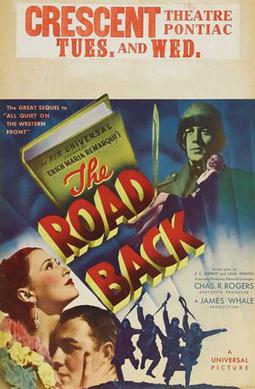
The Road Back is a 1937 American historical drama war film directed by James Whale, starring John King, Richard Cromwell, and Slim Summerville with a supporting cast featuring Andy Devine, Louise Fazenda, Noah Beery Jr., Lionel Atwill, Spring Byington, Al Shean, and an uncredited Dwight Frye. The screenplay is by Charles Kenyon and R. C. Sherriff from the 1931 novel of the same name by Erich Maria Remarque. Combining a strong anti-war message with prescient warnings about the rising dangers of the dictatorship of Nazi Germany, it was intended to be a powerful and controversial picture, and Universal entrusted it to their finest director, James Whale.
Friedrich Kohner, credited professionally as Frederick Kohner, was an Austrian-born novelist and screenwriter, both in Germany and the U.S.
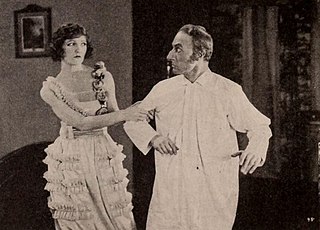
Arnold Lucy was a British theatre and film actor, best known as Professor Kantorek in All Quiet on the Western Front (1930).

All Quiet on the Western Front is a 2022 German epic anti-war film based on the 1929 novel of the same name by Erich Maria Remarque. It is the third film adaptation of the book, after the 1930 and 1979 versions. Co-written, directed and co-produced by Edward Berger, it stars Felix Kammerer, Albrecht Schuch, Daniel Brühl, Sebastian Hülk, Aaron Hilmer, Edin Hasanovic, and Devid Striesow.
Felix Kammerer is an Austrian actor. After working on the Berlin stage, he made his feature film debut by playing the lead role in the war drama All Quiet on the Western Front (2022). He has since starred in the war miniseries All the Light We Cannot See (2023).





















